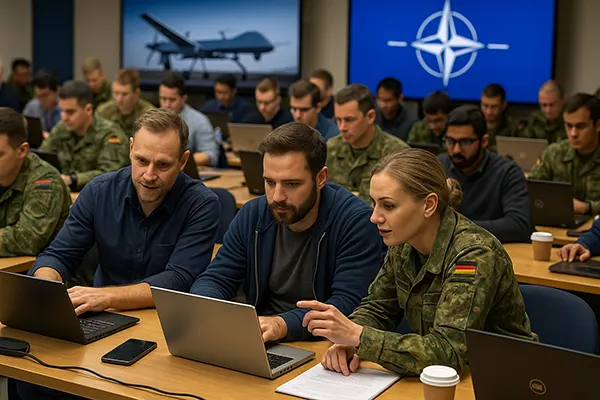Hackathons as a Driver of Defence Technologies in Europe

In recent years, hackathons have become an effective mechanism for accelerating innovation in defence technologies across Europe. These intensive, time-limited events gather developers, engineers, researchers, and security experts who collaborate to create practical solutions for urgent challenges. By uniting diverse expertise, hackathons foster rapid prototyping, test experimental ideas, and strengthen cooperation between public institutions, private companies, and academic circles. In 2025, their role has become even more significant as European states seek innovative methods to enhance security and defence readiness in an increasingly complex geopolitical landscape.
The role of hackathons in European defence innovation
Hackathons have proven to be valuable spaces for testing unconventional ideas in real-world defence scenarios. Unlike long-term research projects, they offer immediate results in the form of prototypes, which can later be refined into operational technologies. European defence ministries and NATO-affiliated programmes have increasingly adopted hackathons as a cost-effective way to address pressing security needs, such as cybersecurity, drone surveillance, and AI-based threat detection.
One of the main strengths of hackathons lies in their ability to bring together multidisciplinary teams. Students, startups, and established defence contractors collaborate in a dynamic environment, leading to unexpected but highly practical solutions. For instance, projects in recent European hackathons have included AI algorithms to identify disinformation campaigns and autonomous navigation systems for unmanned vehicles.
In addition, hackathons provide a unique opportunity to connect civilian innovation with defence requirements. This dual-use approach allows solutions originally developed for civilian industries to be adapted for military applications, reducing development costs and speeding up deployment.
Examples of defence-oriented hackathons in Europe
In 2023 and 2024, several European countries hosted large-scale defence hackathons supported by the European Defence Agency (EDA). These included initiatives focused on improving communications security, detecting cyberattacks, and enhancing situational awareness for troops in the field. Participants worked on developing resilient satellite communications and secure blockchain systems for military logistics.
The NATO Innovation Hub, based in Norfolk but actively cooperating with European partners, regularly organises hackathons that attract specialists from across the continent. Recent challenges have included the use of quantum technologies for secure communications and AI-powered systems for analysing battlefield data in real time.
Smaller national-level hackathons also play a significant role. For example, Baltic states have invested in hackathon programmes designed to develop drone countermeasures, reflecting their frontline position in Europe’s security architecture. These events have already delivered prototypes of radar systems capable of identifying low-flying drones used in asymmetric warfare.
Technological areas shaped by hackathons
Hackathons increasingly focus on areas critical to modern defence strategies. Cybersecurity remains a central theme, as European armed forces face growing risks from state-sponsored hackers and ransomware attacks. Hackathon participants often work on intrusion detection systems, advanced encryption tools, and AI-based threat monitoring.
Another priority field is unmanned systems. From aerial drones to underwater robots, hackathons provide the perfect environment to test prototypes and improve autonomous navigation. Many projects aim to enhance interoperability, ensuring that drones can operate within NATO frameworks and alongside existing European systems.
Artificial intelligence and data analysis are also crucial domains. Hackathon teams develop machine-learning models capable of processing vast amounts of data, helping analysts identify threats and anticipate adversary behaviour. This is particularly relevant for hybrid warfare, where information, cyber, and kinetic operations are increasingly interconnected.
Collaboration between defence, industry, and academia
The success of hackathons depends heavily on the collaboration between different sectors. Defence institutions provide real-world challenges and access to secure datasets, while universities contribute research expertise and fresh talent. Meanwhile, private companies bring technical capabilities and resources that can help scale prototypes into deployable technologies.
European governments have recognised this synergy and launched dedicated funding programmes to support hackathon-driven projects. For example, the European Commission has financed several initiatives under its Horizon Europe programme, specifically targeting dual-use innovations born out of hackathon environments.
In many cases, the outcome of a hackathon continues beyond the event itself. Promising teams often receive incubation support, mentorship, and investment opportunities, ensuring that their solutions can mature into market-ready products. This structured pipeline from idea to implementation makes hackathons not just temporary competitions, but genuine catalysts of long-term innovation.

The strategic future of defence hackathons
Looking ahead, hackathons are likely to become even more deeply integrated into Europe’s defence innovation ecosystem. With the growing complexity of global security challenges, rapid and flexible development methods will be essential. Hackathons provide the agility needed to respond to emerging threats, whether in cyberspace, on land, at sea, or in the air.
In 2025, several European states are planning cross-border hackathons to foster joint innovation and strengthen collective security. These initiatives aim not only to generate technical solutions but also to build networks of trusted professionals who can collaborate during crises. This aligns with NATO’s vision of interoperability and resilience.
Another expected trend is the integration of hackathons into long-term defence planning. By systematically including hackathon outputs in procurement and R&D pipelines, European militaries can accelerate adoption of cutting-edge technologies while maintaining transparency and cost efficiency.
Challenges and limitations
Despite their potential, hackathons are not without challenges. One concern is the security of sensitive data shared during these events. Organisers must ensure that participants operate under strict cybersecurity protocols to prevent leaks or misuse of classified information.
Another limitation lies in the scalability of prototypes. While hackathons are excellent for proof-of-concept development, many ideas require significant investment and time to become fully operational. Bridging this gap between innovation and deployment remains a priority for European defence stakeholders.
Finally, the inclusiveness of hackathons is an ongoing issue. To maximise effectiveness, organisers must encourage participation from underrepresented groups, including women in tech and researchers from smaller institutions. Diverse perspectives strengthen innovation and help address a wider range of security challenges.
